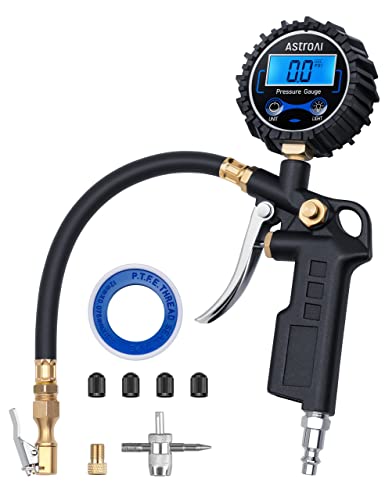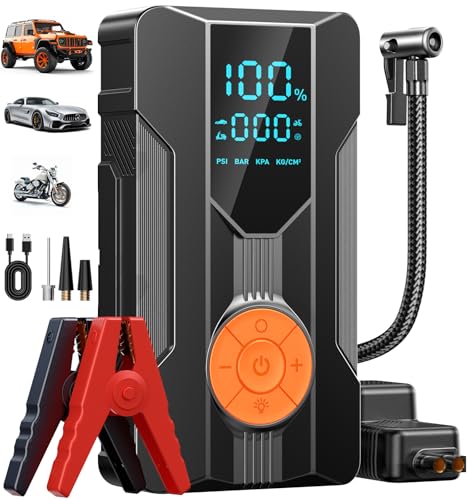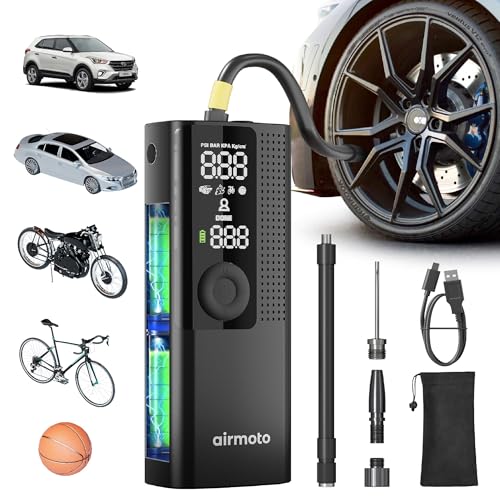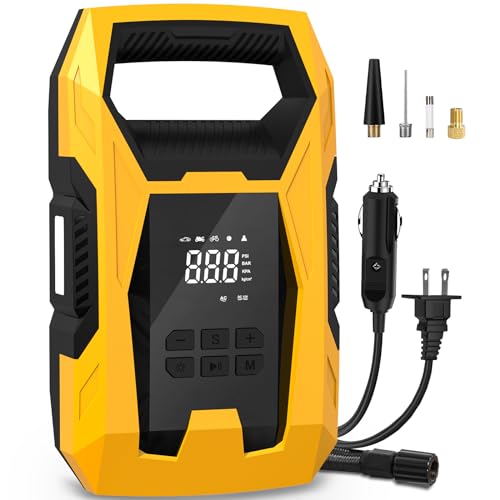Save Time and Hassle with a Digital Tire Inflator
A digital tire inflator is a device used to pump air into vehicle tires and monitor tire pressure digitally. Compared to traditional analog tire gauges, digital inflators offer greater precision and accuracy in measuring tire pressure. They are easy to use, portable, and efficient tools for maintaining proper tire inflation.
Digital tire inflators have an integrated air compressor and digital pressure gauge. They allow users to inflate tires and view the real-time pressure readings on a digital display. Many models also have preset pressure levels so users can select the vehicle manufacturer’s recommended PSI.
The main advantages of using a digital tire inflator include:
- Greater accuracy – Digital gauges offer precise pressure measurements within 0.5 PSI or better. This allows for inflating tires to the vehicle’s exact recommended pressure.
- Easy to read display – Digital readouts eliminate guesswork and the need to check pressure in analog increments. The clear digital display shows the increasing or decreasing tire pressure during inflation.
- Portability – Digital inflators are lightweight and compact. Many cordless models run on rechargeable batteries so they can be easily carried to inflate tires anywhere.
- Efficiency – Digital inflators pump air faster than manual pumps. They have powerful compressors that inflate tires quickly. Preset pressures allow fast one-touch operation.
- Safety features – Digital units have an auto-shutoff when the target pressure is reached. This prevents overinflation which can damage tires.
While digital inflators may cost more than basic gauges, their speed, precision, and convenience make them a useful tool for maintaining optimum tire pressure. Proper inflation is key for fuel efficiency, tread wear, and vehicle handling.
How Digital Tire Inflators Work
Digital tire inflators are designed to make properly inflating your tires easy and accurate. They have several key features that set them apart from traditional tire inflators:
- Digital pressure gauge – Rather than a traditional dial gauge, digital tire inflators have an electronic pressure sensor that provides a digital readout of the tire pressure. This allows for easier viewing and more precise pressure measurements.
- Auto shut-off – Once the desired tire pressure is reached, the auto shut-off automatically stops airflow into the tire. This prevents over-inflation and gives you perfect pressure every time.
- Digital display – The digital display clearly shows the set pressure versus actual measured pressure in real time. Some models can store preset pressures for different tires.
- Cordless operation – Most digital inflators today are powered by rechargeable lithium batteries. This allows for true cordless operation without being tethered to a power outlet.
- Portability – Digital inflators are designed to be very portable. They have compact sizes and many come with their own carrying case.
- Fast inflation – With inflation speeds of 1-3 minutes typically, digital inflators can air up a flat tire very rapidly. This makes them ideal for emergencies.
The advanced electronics in digital inflators take the guesswork out of proper inflation. Features like auto shut-off prevent over-inflation, and the digital readouts allow you to dial in the manufacturer recommended pressure for your specific tires and vehicle. For convenience and accuracy, digital is the way to go.
Top Recommended Models
Digital tire inflators have become an essential automotive accessory for monitoring and maintaining proper tire pressure. With so many models on the market, it can be tricky to determine which is best for your needs. Based on expert tests and customer reviews, here are some of the top recommended digital tire inflators:
Slime 40022 Digital Tire Inflator
The Slime 40022 stands out for its combination of performance, features, and value. This inflator offers an automatic shut-off when the target pressure is reached. It includes an easy-to-read digital pressure gauge and built-in LED light. The 40022 delivers up to 0.5 CFM and can inflate a standard car tire in about 5 minutes. It plugs into a 12V DC outlet and comes with multiple nozzle adapters.
According to professional tests, the 40022 consistently reaches set pressures with accuracy. Thousands of customers praise this inflator’s sturdy construction, reliability, and ease of storage. While it lacks some bells and whistles, its proven ability to inflate tires makes it a top choice.

Tirewell 12V Tire Inflator
This popular inflator features a digital pressure display, built-in flashlight, and automatic shut-off. The rapid inflator nozzle provides a quick fill of 35L per minute. In customer tests, the Tirewell inflated a mid-size car tire in under 3 minutes. It’s able to meet pre-set pressures within 1 PSI accuracy.
The Tirewell stands out for its durable metal housing and rugged inflator hose. It comes with multiple nozzle attachments for balls, bikes, and inflatable items too. Thousands of happy drivers report this inflator is reliable, long-lasting, and well-worth the investment.
AstroAI Digital Tire Pressure Gauge
For an inflator with digital precision, the AstroAI digital tire inflator is a top choice. This inflator allows you to set a desired pressure between 0-150 PSI. It automatically stops when reaching the target inflation level. The easy-to-read LCD display provides tire pressures to within 0.1 PSI accuracy.
This inflator includes an LED flashlight and inflation nozzle adaptors. At 1.06 CFM, it can fully inflate a standard tire in about 4 minutes. Customers praise its consistent accuracy, durability, and performance. For those seeking digital-level tire inflation, the AstroAI is a great solution.

Tips for Proper Tire Inflation
Proper tire inflation is crucial for safe driving and maximizing your tires’ lifespan. Here are some key tips:
- Check your tire pressures at least once a month and before long road trips. Use an accurate tire pressure gauge, don’t just eyeball it. Most cars have a sticker inside the driver’s door or gas hatch showing the vehicle’s recommended tire pressures. Note that the pressures listed are for cold tires, so check inflation when the tires haven’t been driven on for at least 3 hours.
- Adjust your pressures according to load – add 2-3 psi for every passenger or 100 lbs of cargo to avoid tire deformation and overworking the tire sides. Consult your owner’s manual or tire placard for specific load inflation guidance.
- Adjust for weather and temperature changes. For every 10°F change in outside temperature, tire pressures change 1 psi. Inflate to the higher, warm weather end of the recommended pressure range before peak summer temperatures hit. In winter, add 2-3 psi to compensate for cold weather pressure drops.
- Don’t overinflate beyond your vehicle’s max pressure specification, as this causes harsher rides, uneven treadwear, and increases blowout risk on hot roads. Overinflation also offers negligible benefit for fuel economy, while proper inflation does improve MPG.
- Check your spare tire pressure too! Nothing worse than finding a flat spare when you need it due to gradual air leakage while stored.
- Consider “plus-sizing” your tires for an extra safety margin if you’ll drive with near max loads frequently. Install tires with a higher max pressure rating to allow inflating a few PSI over standard pressures when heavily loaded.
Properly inflated tires will last longer, run quieter, grip better, and save you money at the gas pump. Just a few extra minutes each month checking pressures can make a big difference. Investing in your own digital tire inflator also makes regular inflation maintenance quick and convenient.
Calibrating Digital Tire Inflators
Proper calibration is crucial for ensuring the accuracy of digital tire inflator readings. An uncalibrated unit may provide incorrect pressure measurements, leading to improperly inflated tires.
Digital tire inflators should be calibrated according to the manufacturer’s recommendations, usually every 1-2 years. Calibration intervals may need to be more frequent with heavy use or exposure to extreme conditions.
The calibration process typically involves:
- Comparing the inflator’s pressure readings against a known accurate standard such as a recently calibrated mechanical pressure gauge.
- Making small adjustments to the inflator based on any variance from the standard. This is usually done via a calibration screw or button on the inflator.
- Testing and re-testing readings at various pressures and making further adjustments until the inflator is within an acceptable accuracy range of the standard (often within 1-2 psi).
- Recording the date of calibration and any notes for future reference.
Proper calibration tools like a calibrated test gauge, inflation source, and fittings compatible with the inflator are required. Users should closely follow the manufacturer’s instructions.
Calibrating too frequently runs the risk of throwing off the readings. But periodic calibration according to the manufacturer’s recommendations will maximize accuracy and reliability. Consistently verifying readings against a known standard is prudent as well.
Accurate pressure is crucial for proper tire inflation, safety, and performance. So calibrating digital tire inflators routinely is a small effort that pays big dividends.
Safety Tips
Using a digital tire inflator properly is crucial for safe operation. Here are some key safety tips to keep in mind:
- Always read the instruction manual thoroughly before using your digital tire inflator. Follow all operating procedures and safety precautions.
- Never leave the inflator unattended while it is operating. Stay within arm’s reach in case you need to make adjustments or stop inflation immediately.
- Wear protective eyewear to avoid injury from dust or particles that may kick up when inflating.
- Make sure the inflator is on a stable, flat surface and won’t tip over while inflating. Don’t hold it in your hands while in operation.
- Check tire pressure frequently during inflation to avoid over-inflation. Most digital inflators have auto shut-off at the target pressure.
- Ensure no one is standing directly over or in front of the tire during inflation. Tires can explode if over-inflated.
- Keep all body parts, clothing, and tools away from moving parts when operating the inflator.
- Avoid inflating tires that are visibly damaged, as they could burst under added pressure.
- Use a pressure gauge to double check digital readout for accuracy. Calibrate regularly.
- Check inflator fittings for wear and damage before each use, and replace as needed.
Following proper use guidelines is crucial for safe digital tire inflator operation. Never leave the inflator unattended during inflation to avoid serious injuries.
Maintenance
Proper maintenance is key to keeping your digital tire inflator working properly over the long run. Here are some tips for maintaining your tire inflator:
Cleaning
- Use a damp cloth to wipe down the exterior of the inflator to remove any dirt or debris after each use. Avoid submerging the inflator in water or using harsh cleaners.
- Check the air filter regularly and clean or replace it as needed. A dirty filter can reduce airflow and performance.
- Clean the tire pressure gauge with a soft brush or compressed air to remove any dust or particles. Don’t use liquids or solvents.
- Inspect the air hose and make sure it’s free of obstructions. Clean with a damp cloth if needed.
Storing
- Allow the inflator to fully cool down before storing. Never store it while it’s still hot.
- Store the inflator in a clean, dry location out of direct sunlight and extreme temperatures.
- Wrap the power cord neatly and avoid kinking the hose.
- If storing for an extended time, run the inflator briefly every few months to keep the internal parts lubricated.
Replacing Parts/Batteries
- Replace the air filter when it becomes excessively dirty per the manual’s recommendation.
- Inspect belts, hoses, wiring etc. and replace any cracked or damaged parts.
- For battery-powered models, replace the battery when runtime drops significantly.
- Use only manufacturer recommended replacement parts to maintain performance and safety.
Following proper maintenance guidelines will help keep a digital tire inflator working optimally for years of reliable service. Be sure to consult the user manual for model-specific guidance. Proper care goes a long way!
Troubleshooting Issues
All digital tire inflators can encounter problems from time to time. Here are some of the most common troubleshooting issues and solutions:
Inaccurate Pressure Readings
If your digital inflator is giving you inaccurate tire pressure readings, there are a few things you can try:
- Check the batteries – weak or old batteries can affect the performance of the digital display. Replace batteries if needed.
- Reset the inflator – turn it off and back on again to reset the digital display.
- Check for air leaks – leaks in the tire, inflator hose, or connections can cause inconsistent readings. Listen for air hissing out and re-check connections.
- Calibrate the inflator – follow the user manual instructions to calibrate and reset the inflator to improve accuracy.
- Clean the sensors – dust or dirt on the pressure sensors can affect readings. Use a can of compressed air to clean sensors.
- Replace the inflator – if other troubleshooting doesn’t work, the sensor may be faulty. Consider replacing the inflator.
Error Codes
Some digital inflators will display error codes to indicate a problem. Check the user manual for your particular model to determine what different error codes mean.
Common error codes include:
- Err1 – Pressure sensor error
- Err2 – Air temperature sensor error
- Err3 – Inflation error, usually a faulty pump or motor
- Err4 – Power supply error, check batteries
Refer to manufacturer guidelines for how to clear error codes on your inflator model.
Other Issues
- Pump not turning on – Check batteries, battery connections, fuses if applicable. Try resetting.
- Slow or weak inflation – Could indicate an air leak, blocked pump filter, or worn pump. Inspect components and connections.
- Buttons or display unresponsive – May signal an electronic control board failure. Try resetting, check for loose connections.
- Loud noise during operation – Could be a bad motor bearing or debris stuck in pump. Have technician inspect internal pump parts.
If you are still experiencing problems after trying basic troubleshooting, contact the manufacturer or take inflator in for professional service. Be sure to have your user manual and receipt on hand.
Accessories
A digital tire inflator is only as good as the accessories you pair with it. Here are some must-have accessories that will make tire inflation easier, faster, and more accurate.
Pressure Gauges
A high quality pressure gauge is essential for precise tire pressure readings. Built-in gauges on inflators can lose accuracy over time. An external gauge allows you to double check the pressure and calibrate your inflator. Look for a gauge that reads in 0.5 psi or 0.1 psi increments for maximum precision.
Popular options like the Milton S-921 Passenger Car Tire Gauge have a sturdy, steel-reinforced hose and large easy-to-read dial. Make sure to choose a gauge rated for your tire pressure range.
Inflator Nozzles
The type of nozzle can make a big difference in ease of use. Upgraded nozzles like the
Milton Air Chuck allow you to lock onto the tire valve for hands-free inflation. Rotating nozzles ensure the hose doesn’t kink at awkward angles.
Look for nozzles that fit both standard car valves and extended truck valves. Nozzles with bleeder valves can fine tune pressure by slowly letting air out.
Protective Cases
A protective case will keep your inflator safe from damage while storing at home or transporting in your vehicle. Look for a durable case, ideally with padding to cushion your inflator. Some cases include space for accessories like nozzles and pressure gauges.
Waterproof hard cases offer the most protection for frequent travelers. A soft portable case works for occasional use. Pick the right size case for your inflator model.
With the right accessories, your digital tire inflator will deliver accurate, convenient tire inflation for many years to come. Investing in must-have add-ons will improve performance and make your inflator easier to use effectively.
Conclusion
Digital tire inflators are an excellent tool for keeping your tires properly inflated. As this guide has shown, they have several key benefits compared to traditional manual tire gauges and inflators:
- Precision – Digital tire inflators provide highly accurate pressure readings, removing the guesswork and imprecision of traditional analog gauges. This allows you to confidently inflate your tires to the manufacturer’s recommended PSI.
- Convenience – With the ability to both measure and inflate tires, digital inflators combine two tools in one. Their portable design with built-in batteries makes them easy to store in your vehicle and use anytime.
- Automatic Shutoff – Digital inflators automatically stop inflating when they reach the set pressure. This prevents over-inflation and makes the process hands-free.
- Safety Features – Models like auto-off when disconnected from the tire valve stem prevent dangerous bursts of air. Audible alerts indicate when the target pressure is reached.
- Durability – Digital inflators are made of high-quality components to withstand frequent use over time. Their digital displays remain accurate for longer than analog gauges.
- Ease of Use – With a simple interface of buttons and digital display, digital inflators are very intuitive to operate even for beginners. Just set your desired PSI and attach to the valve stem.
For home use or on the go, a digital tire inflator is an essential tool for drivers who want safe, properly inflated tires and maximum fuel economy. This guide covers the key factors to consider when choosing the right digital inflator for your needs.







